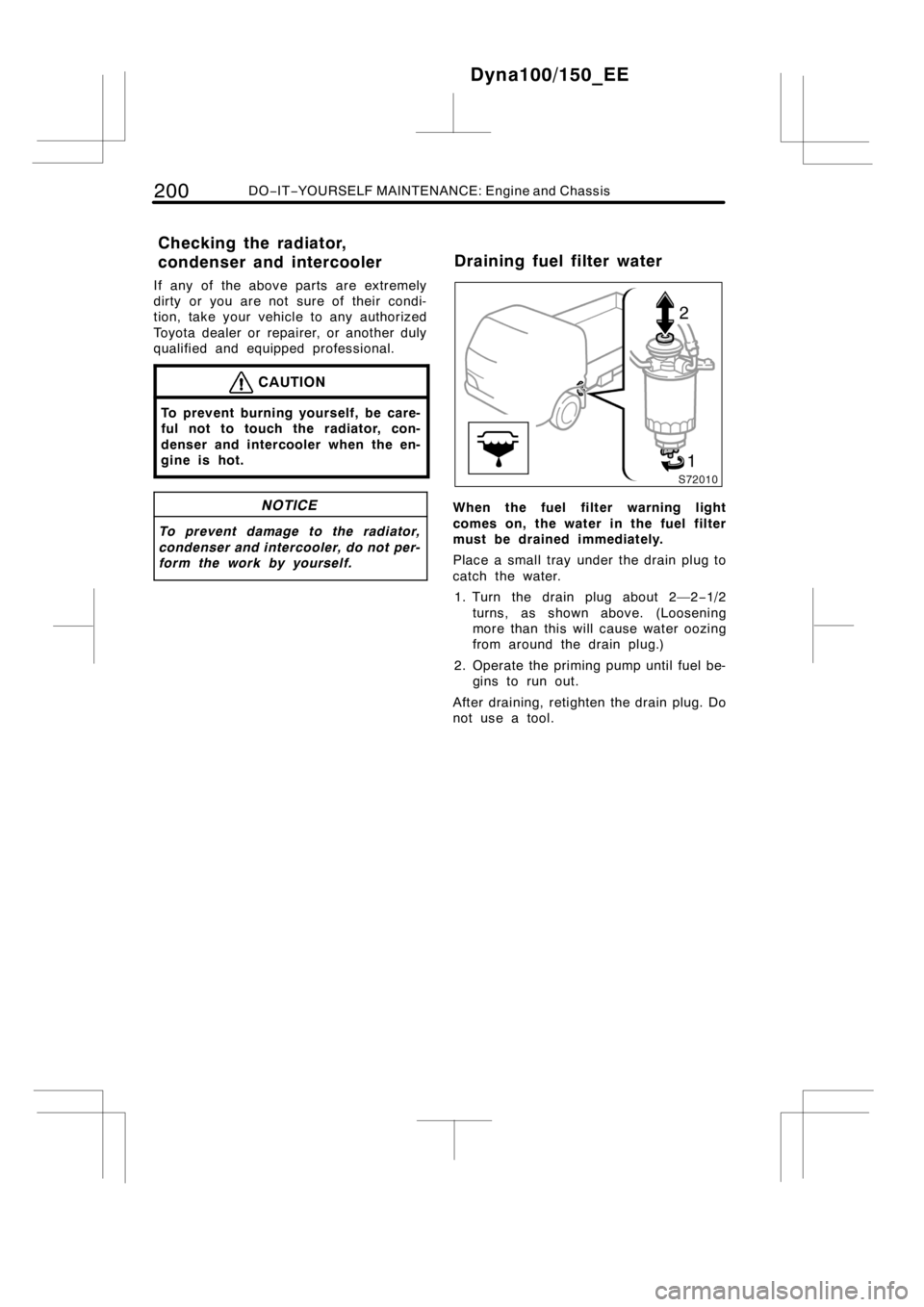2012 TOYOTA DYNA 100/150 check engine
[x] Cancel search: check enginePage 176 of 240

170IN CASE OF AN EMERGENCY
11. Check the air pressure of the re-
placed tire.
Adjust the air pressure to the specification
designated on page 226 in Section 8. If
the pressure is lower, drive slowly to the
nearest service station and fill to the cor-
rect pressure.
Do not forget to reinstall the tire inflation
valve cap as dirt and moisture could get
into the valve core and possibly cause air
leakage. If the cap is missing, have a new
one put on as soon as possible.
12. Restow all the tools, jack and flat
tire securely.
Front and single rear tires—
As soon after changing wheels as pos-
sible, tighten the wheel nuts to the torque
specified on page 226 in Section 8 with
a torque wrench. Have a technician repair
the flat tire.
Double rear tires—
As soon after changing wheels as pos-
sible, tighten the stop bolts and wheel
nuts to the torque specified on page 226
in Section 8 with a torque wrench. Have
a technician repair the flat tire.
This is the same procedure for changing
or rotating your tires.
CAUTION
Before driving, make sure all the
tools, jack and flat tire are securely
in place in their storage location to
reduce the possibility of death or se-
rious injury during sudden braking,
sudden swerving or an accident.
If your vehicle becomes stuck in snow,
mud, sand, etc., then you may attempt
to rock the vehicle free by moving it
forward and backward.
CAUTION
Do not attempt to rock the vehicle
free by moving it forward and back-
ward if people or objects are any-
where near the vehicle. During the
rocking operation the vehicle may
suddenly move forward or backward
as it becomes unstuck, causing injury
or damage to nearby people or ob-
jects.
NOTICE
If you rock your vehicle, observe the
following precautions to prevent dam-
age to the transmission and other
parts.
zDo not race the engine and avoid
spinning the wheels.
zIf your vehicle remains stuck after
rocking the vehicle several times,
consider other ways such as tow-
ing.
Dyna100/150_EE
—After changing wheelsIf your vehicle becomes
stuck
Page 191 of 240

MAINTENANCE REQUIREMENTS185
Note, however, that some maintenance
tasks require special tools and skills.
These are best performed by qualified
technicians. Even if you’re an experienced
do−it−yourself mechanic, we recommend
that repairs and maintenance be con-
ducted by an authorized Toyota dealer or
repairer, or another duly qualified and
equipped professional. Any authorized
Toyota dealer or repairer will keep a
record of maintenance, which could be
useful should you ever require Warranty
Service. Should you choose to select a
qualified and equipped professional other
than an authorized Toyota repairer to
service or maintain your vehicle, we
recommend that you request that a record
of maintenance be kept.
The service interval for scheduled main-
tenance is determined by the odometer
reading or time interval, whichever
comes first, shown in the schedule.
Rubber hoses (for cooling and heater
system, brake system and fuel system)
should be inspected by a qualified tech-
nician in accordance with the Toyota
maintenance schedule.
They are particularly important mainte-
nance items. Have any deteriorated or
damaged hoses replaced immediately.
Note that rubber hoses will deteriorate
with age, resulting in swelling, chafing or
cracks.Be on the alert for changes in perfor-
mance, sounds, and visual tip−offs that
indicate service is needed. Some impor-
tant clues are as follows:
DEngine missing, stumbling, or pinging
DAppreciable loss of power
DStrange engine noises
DA leak under the vehicle (However, wa-
ter dripping from the air conditioning
after use is normal.)
DChange in exhaust sound (This may
indicate a dangerous carbon monoxide
leak. Drive with the windows open and
have the exhaustsystem checked im-
mediately.)
DFlat−looking tire; excessive tire squeal
when cornering; uneven tire wear
DVehicle pulls to one side when driving
straight on a level road
DStrange noises related to suspension
movement
DLoss of brake effectiveness; spongy
feeling brake or clutch pedal; pedal al-
most touches floor; vehicle pulls to one
side when braking
DEngine coolant temperature continually
higher than normal
If you notice any of these clues, take your
vehicle to any authorized Toyota dealer or
repairer, or another duly qualified and
equipped professional, as soon as pos-
sible. It probably needs adjustment or re-
pair.
CAUTION
Do not continue driving with the ve-
hicle unchecked. It could result in se-
rious vehicle damage and possibly se-
rious injury.
Dyna100/150_EE
Does your vehicle need
repairing?
Page 200 of 240

194DO−IT−YOURSELF MAINTENANCE: Introduction
NOTICE
zRemember that battery cables carry
high currents. Be careful of acci-
dentally causing a short circuit.
zAdd only “Toyota Super Long Life
Coolant” or similar high quality eth-
ylene glycol based non−silicate,
non−amine, non−nitrite, and non−bo-
rate coolant with long−life hybrid
organic acid technology to fill the
radiator. “Toyota Super Long Life
Coolant” is a mixture of 50% cool-
ant and 50% deionized water.
zIf you spill some of the coolant, be
sure to wash it off with water to
prevent it from damaging the parts
or paint.
zDo not overfill power steering fluid,
or the power steering could be
damaged.
zIf you spill brake fluid, be sure to
wash it off with water to prevent it
from damaging the parts or paint.
zDo not drive with the air cleaner
filter removed, or excessive engine
wear could result.
zBe careful not to scratch the glass
surface with the wiper frame.
zWhen closing the engine access
hole cover or lowering the cab,
check to see that you have not for-
gotten any tools, rags, etc.
Dyna100/150_EE
Page 201 of 240

DO−IT−YOURSELF MAINTENANCE: Engine and Chassis195
Section 7−2
DO−IT−YOURSELF MAINTENANCE
Engine and Chassis
DChecking the engine oil level 196........................
DChecking the engine coolant level 198...................
DChecking the radiator, condenser and intercooler 200.....
DDraining fuel filter water 200............................
DChecking tire inflation pressure 201.....................
DChecking and replacing tires 202........................
DRotating tires 203......................................
DInstalling snow tires and chains 204.....................
DReplacing wheels 205..................................
Dyna100/150_EE
Page 202 of 240

196DO−IT−YOURSELF MAINTENANCE: Engine and Chassis
Low level Full level
Add oil O.K. Too full
With the engine at operating tempera-
ture and turned off, check the oil level
on the dipstick.
1. To get a correct reading, the vehicle
should be on level ground. After warm-
ing up the engine and turning it off,
wait more than five minutes for the oil
to drain back into the bottom of the
engine.
2. Pull the dipstick out, hold a rag under
the end and wipe it clean.
3. Reinsert the dipstick—push it in as far
as it will go, or the reading will not be
correct.
4. Pull the dipstick out and look at the oil
level while holding a rag under the
end.
NOTICE
Be careful not to drop engine oil on
the vehicle components.
If the oil level is below or only slightly
above the low level, add engine oil of
the same type as already in the engine.
Remove the oil filler capand add engine
oil in small quantities at a time, checking
the dipstick. We recommend that you use
a funnel when adding oil.The approximate quantity of oil needed to
raise the level between low and full on the
dipstick is indicated as follows:
1.9L(2.0qt.,1.7Imp.qt.)
For the engine oil capacity, see “Service
specifications” on page 224 in Section 8.
When the level reaches within the correct
range, install the filler cap hand−tight.
NOTICE
zBe careful not to spill engine oil on
the vehicle components.
zAvoid overfilling, or the engine
could be damaged.
zCheck the oil level on the dipstick
once again after adding the oil.
Dyna100/150_EE
Checking the engine oil level
Page 204 of 240

198DO−IT−YOURSELF MAINTENANCE: Engine and Chassis
To ensure excellent lubrication perfor-
mance for your engine, Toyota recom-
mends the use of “Toyota Genuine Motor
Oil”, which has been specifically tested
and approved for all Toyota engines.
Please contact any authorized Toyota
dealer or repairer for further details about
“Toyota Genuine Motor Oil”. Other motor
oils of matching quality also be used.Look at the see−through coolant reser-
voir when the engine is cold. The cool-
ant level is satisfactory if it is between
the “FULL” and “LOW” lines on the
reservoir. If the level is low, add the
coolant. (For the coolant type, see
“Coolant type selection” described be-
low.)
The coolant level in the reservoir will vary
with engine temperature. However, if the
level is on or below the “LOW” line, add
coolant. Bring the level up to the “FULL”
line.
If the coolant level drops within a short
time after replenishing, there may be a
leak in the system. Visually check the
radiator, hoses, radiator cap and drain
cock and water pump.
If you can find no leak, have any autho-
rized Toyota dealer or repairer, or another
duly qualified and equipped professional,
test the cap pressure and check for leaks
in the cooling system.
CAUTION
To prevent burning yourself, do not
remove the radiator cap when the en-
gine is hot.
Dyna100/150_EE
Checking the engine coolant
level
Page 206 of 240

200DO−IT−YOURSELF MAINTENANCE: Engine and Chassis
If any of the above parts are extremely
dirty or you are not sure of their condi-
tion, take your vehicle to any authorized
Toyota dealer or repairer, or another duly
qualified and equipped professional.
CAUTION
To prevent burning yourself, be care-
ful not to touch the radiator, con-
denser and intercooler when the en-
gine is hot.
NOTICE
To prevent damage to the radiator,
condenser and intercooler, do not per-
formtheworkbyyourself.
When the fuel filter warning light
comes on, the water in the fuel filter
must be drained immediately.
Place a small tray under the drain plug to
catch the water.
1. Turn the drain plug about 2—2−1/2
turns, as shown above. (Loosening
more than this will cause water oozing
from around the drain plug.)
2. Operate the priming pump until fuel be-
gins to run out.
After draining, retighten the drain plug. Do
not use a tool.
Dyna100/150_EE
Checking the radiator,
condenser and intercoolerDraining fuel filter water
Page 207 of 240

DO−IT−YOURSELF MAINTENANCE: Engine and Chassis201
Keep your tire inflation pressures at the
proper level.
The recommended cold tire inflation pres-
sures and tire sizes are given on page
226 in Section 8.
You should check the tire inflation pres-
sure every two weeks, or at least once a
month. And do not forget the spare!
Incorrect tire inflation pressure may waste
fuel, reduce the comfort of driving, reduce
tire life and make your vehicle less safe
to drive.
If a tire frequently needsrefilling,have it
checked by any authorized Toyota dealer
or repairer, or another duly qualified and
equipped professional.
The following instructions for checking
tire inflation pressure should be ob-
served:
DThe pressure should be checked only
when the tires are cold.If your ve-
hicle has been parked for at least 3
hours and has not been driven for
more than 1.5 km or 1 mile since, you
will get an accurate cold tire inflation
pressure reading.
DAlways use a tire pressure gauge.
The appearance of a tire can be mis-
leading. Besides, tire inflation pressur-
es that are even just a few pounds off
can degrade ride and handling.
DDo not bleed or reduce tire inflation
pressure after driving.It is normal for
the tire inflation pressure to be higher
after driving.
DBe sure to reinstall the tire valve
caps.Without the valve caps, dirt or
moisture could get into the valve core
and cause air leakage. If the caps
have been lost, have new ones put on
as soon as possible.
CAUTION
Keep your tires properly inflated.
Otherwise, the following conditions
may occur and cause an accident re-
sulting in death or serious injuries.
Low tire pressure (underinflation)—
DExcessive wear
DUneven wear
DPoor handling
DPossibility of blowouts from an
overheated tire
DPoor sealing of the tire bead
DWheel deformation and/or tire sepa-
ration
DA greater possibility of tire damage
from road hazards
High tire pressure (overinflation)—
DPoor handling
DExcessive wear
DUneven wear
DA greater possibility of tire damage
from road hazards
Dyna100/150_EE
Checking tire inflation
pressure